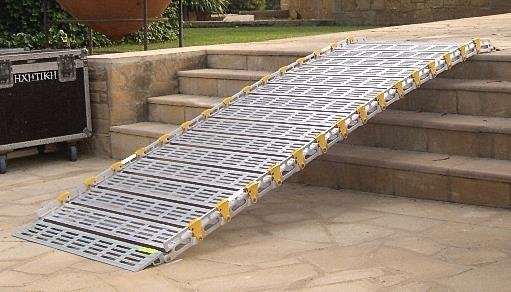Navigating the world with a wheelchair should be an empowering experience, not an obstacle course. For many individuals and caregivers, portable ramps for wheelchairs are essential tools that provide access to homes, public spaces, and transportation. These versatile solutions make it easier to conquer steps, curbs, and uneven surfaces without compromising safety or comfort.
Imagine being able to glide up a ramp instead of struggling with stairs. Whether you’re heading to a friend’s house or embarking on an adventure in the great outdoors, having the right portable ramp can open doors—quite literally! With so many options available today, understanding what portable ramps offer is key to enhancing mobility and independence.
This ultimate guide will walk you through everything you need to know about portable ramps for wheelchairs—from different types available on the market to how they can significantly improve your daily life. Let’s dive in!
What Are Portable Ramps For Wheelchairs?
Portable ramps for wheelchairs are designed to provide a seamless transition between different surfaces. They help users navigate obstacles such as steps, curbs, and doorways with ease.
These ramps are lightweight and easy to transport. Their compact design allows caregivers or users to carry them anywhere. Whether it’s a quick trip to the grocery store or visiting friends, having a portable ramp makes mobility more convenient.
Typically made from durable materials like aluminum or fiberglass, these ramps can withstand daily use while ensuring safety. Many feature non-slip surfaces for added traction.
Some models come with folding mechanisms that make storage simple when not in use. This versatility is essential for those who need accessibility on-the-go without permanent installations.
Types of Portable Ramps For Wheelchairs
Portable ramps for wheelchairs come in various styles, each designed to meet specific needs.
Folding ramps are popular due to their convenience. They can be easily stored and transported, making them great for on-the-go accessibility.
Telescoping ramps offer adjustable lengths. This flexibility allows users to customize the ramp based on the height of the surface they need to access.
Threshold ramps help bridge small gaps at doorways or curbs. These compact solutions ensure smooth transitions without unnecessary lifting.
Solid modular ramps provide a more permanent solution while still being portable. They can be assembled quickly and disassembled just as easily when needed.
Suitcase-style ramps combine portability with durability. Their design resembles a suitcase that opens up for use and folds back down for transport.
With these options available, there’s likely a style suited for every wheelchair user’s situation.
Factors to Consider When Choosing a Portable Ramp
Choosing the right portable ramp for wheelchairs involves several important factors. First, consider the weight capacity. Ensure that the ramp can support both the wheelchair and its user comfortably.
Next, think about the length and incline of the ramp. A longer ramp means a gentler slope, making it easier to navigate. However, space constraints might limit your options.
Material is another crucial aspect. Aluminum ramps are lightweight yet durable while plastic models tend to be more affordable but may lack stability.
Portability features also matter. Look for ramps with foldable designs or handles for easy transport and storage.
Assess surface grip to ensure safety during use. Ramps should have non-slip surfaces to prevent accidents in wet or slippery conditions. These considerations will help you find a suitable portable ramp tailored to specific needs.
Benefits of Using a Portable Ramp
Portable ramps for wheelchairs offer unmatched convenience. They allow users to navigate various terrains effortlessly, from curbs to steps.
These ramps are lightweight and easy to transport, making them ideal for travel. Whether you’re visiting friends or tackling outdoor adventures, a portable ramp can be your reliable companion.
Accessibility is another significant advantage. With the right ramp, barriers become manageable obstacles rather than insurmountable challenges.
Safety plays a critical role too. Many designs feature non-slip surfaces that enhance grip and stability during use. This reduces the risk of accidents and provides peace of mind.
Moreover, using a portable ramp encourages independence. Users can take control of their mobility without relying on others for assistance in accessing different locations.
These ramps promote inclusivity in public spaces and homes alike, allowing everyone to enjoy experiences together without limitations.
How to Properly Use a Portable Ramp
Using a portable ramp correctly is essential for safety and ease of access. Start by ensuring the surface where you place the ramp is stable and level. This prevents slippage during use.
Next, position the ramp at an appropriate angle. A gentle slope usually works best—ideally, a 1:12 ratio of rise to run. This makes it easier for users to navigate without undue strain.
Always secure the ramp in place if possible. Use anti-slip mats or weights designed for this purpose to minimize movement while in use.
When using the ramp, encourage proper techniques like rolling straight up or down rather than at an angle. This reduces risks and ensures smoother transitions.
If someone else is assisting, communication is key. Ensure everyone knows when to start moving so that both parties act simultaneously for optimal support and balance.
Top 5 Portable Ramps on the Market
When it comes to portable ramps for wheelchairs, choosing the right one can transform accessibility. Here are five standout options that cater to various needs.
First up is the **EZ-Access Suitcase Ramp**. This lightweight ramp offers a foldable design that’s easy to transport and set up anywhere.
Next, consider the **Titan Ramps Folding Wheelchair Ramp**. Its sturdy aluminum construction provides excellent support while remaining incredibly portable.
For those seeking versatility, the **Goplus Portable Wheelchair Ramp** features adjustable heights and widths, making it perfect for uneven surfaces.
Another notable option is the **Silver Spring Foldable Wheelchair Ramp**, designed with a non-slip surface for enhanced safety during use.
Check out the **Prairie View Industries Aluminum Threshold Ramp**. Ideal for doorways, this ramp ensures seamless transitions in and out of homes or buildings.
Alternative Solutions for Wheelchair Accessibility
When portable ramps don’t fit your needs, several alternative solutions can enhance wheelchair accessibility.
One option is the use of stairlifts. These devices transport individuals up and down stairs safely. They are often installed in homes where traditional ramps may not be feasible.
Another solution is platform lifts, which can elevate a wheelchair to different levels in buildings without steps. Unlike ramps, these lifts require more space but offer a permanent fix for multi-level access.
For outdoor environments, consider modular ramp systems designed to adapt easily to various locations. These systems are customizable and can suit specific height requirements.
Additionally, curb cuts or tactile paving at crosswalks improve navigation for wheelchair users in urban settings. Such modifications ensure smoother transitions from sidewalks to streets.
Community initiatives also play a crucial role. Advocacy groups often work with local governments to promote accessible designs in public spaces.
Conclusion
Portable ramps for wheelchairs play a vital role in enhancing mobility and independence. They provide an essential solution for individuals with limited mobility, making everyday tasks much more manageable.
With various types available, users can find options that best suit their specific needs. Each ramp offers unique features and benefits, ensuring accessibility in different environments.
Choosing the right portable ramp involves considering several factors like weight capacity, material durability, and ease of use. It’s crucial to evaluate these aspects carefully to ensure safety and reliability.
Investing in a quality portable ramp can significantly improve day-to-day life. Whether you’re navigating steps or curbs, having the right equipment opens up opportunities for travel and exploration.
Exploring alternative solutions further expands access possibilities. With so many resources available today, everyone deserves to enjoy freedom of movement without barriers.
FAQs
Q: What are portable ramps for wheelchairs?
A: Portable ramps for wheelchairs are lightweight, versatile solutions that provide wheelchair users with easy access to various surfaces. They can be used at home, work, or public locations where traditional accessibility options may not be available.
Q: How do I choose the right portable ramp?
A: Selecting the right portable ramp involves considering factors such as weight capacity, length and angle of incline, material durability, and ease of storage. It’s crucial to assess your specific needs based on frequency of use and terrain types.
Q: Are there different types of portable ramps?
A: Yes! There are several types including folding ramps, telescoping ramps, threshold ramps, and modular systems. Each type serves unique purposes depending on mobility requirements and the environments in which they will be used.
Q: Can anyone use a portable ramp?
A: While designed primarily for wheelchair users, many people who have difficulty walking or using crutches can also benefit from these devices. However, it’s essential to ensure that any user is capable of navigating safely with their equipment.
Q: How do I maintain my portable ramp?
A: Regular checks for wear and tear are vital. Ensure that all parts function correctly without obstructions. Cleaning the surface helps maintain traction and safety when in use.
Q: Where can I purchase portable ramps for wheelchairs?
A: You can find them at medical supply stores or online retailers like Amazon. Always look out for customer reviews to gauge quality before making a decision.
Q: Do I need a professional assessment before purchasing a ramp?
A: It isn’t mandatory but consulting an occupational therapist or mobility specialist might help you make informed choices tailored specifically to your needs.
Q: What should I do if my ramp doesn’t fit properly?
A: If you encounter sizing issues after purchase—most manufacturers offer return policies so check their guidelines first; sometimes adjustments can also resolve fitting problems effectively.
These FAQs address common concerns while highlighting important information related to choosing suitable solutions among numerous options available today regarding accessible living aids like those wonderful little wonders we call “portable ramps.”

















